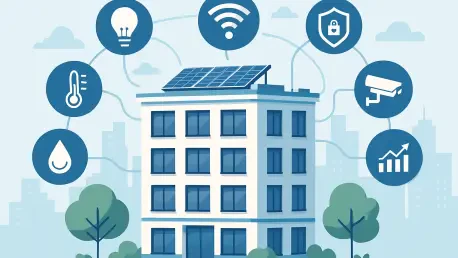The realm of building automation is undergoing a transformative shift as the demand for smarter, more energy-efficient infrastructure skyrockets across the globe, driven by rapid urbanization and a growing emphasis on sustainability. With sustainability becoming a non-negotiable priority for governments and businesses alike, building automation and controls (BAC) systems are emerging as the backbone of modern architecture. These systems, which manage critical operations like HVAC, lighting, security, and energy consumption, are not just enhancing occupant comfort but also driving significant cost savings. As technological advancements such as IoT and AI continue to redefine the landscape, the market for these solutions is poised for remarkable growth over the next decade, from now through 2035. This surge reflects a broader push toward intelligent, data-driven building management that aligns with global environmental goals.
Market Dynamics and Growth Drivers
Technological Innovations Fueling Expansion
The rapid evolution of technology stands as a primary catalyst for the burgeoning BAC market, with innovations in the Internet of Things (IoT), artificial intelligence (AI), and cloud-based platforms leading the charge. These advancements enable buildings to transition from static structures to dynamic ecosystems that adapt in real-time to occupancy patterns and energy needs. Smart sensors and connected devices now collect vast amounts of data, allowing for predictive maintenance and optimized resource use. This not only reduces operational costs but also minimizes environmental impact, aligning with stringent regulations on carbon emissions. Moreover, the integration of AI-driven analytics empowers facility managers to make informed decisions, enhancing both efficiency and safety. As these technologies become more accessible, their adoption is expected to accelerate across commercial, industrial, and residential sectors, pushing market boundaries further through 2035.
A parallel trend amplifying this growth is the increasing emphasis on cybersecurity within building automation systems. As buildings become more connected, the risk of cyber threats looms larger, necessitating robust security protocols to protect sensitive data and critical infrastructure. Industry leaders are investing heavily in developing secure, encrypted solutions to safeguard against breaches that could compromise safety or disrupt operations. Additionally, the shift toward remote management tools—spurred by the need for contactless operations in recent times—has further highlighted the importance of secure, reliable systems. This dual focus on innovation and protection is creating fertile ground for market expansion, as stakeholders seek solutions that balance cutting-edge functionality with uncompromised safety. The trajectory suggests a sustained upward climb as these priorities shape the industry’s future.
Challenges Hindering Adoption
Despite the promising outlook, the BAC market faces notable hurdles that could slow its momentum, particularly in regions with limited resources. High initial costs associated with installing advanced automation systems remain a significant barrier, especially for small to medium-sized enterprises or developing economies where budget constraints are prevalent. These upfront expenses often deter potential adopters, even when long-term savings on energy and maintenance are evident. Furthermore, the complexity of integrating new systems with existing infrastructure poses technical challenges, requiring specialized expertise that may not be readily available in all markets. Such obstacles underscore the need for scalable, cost-effective solutions that can cater to diverse economic landscapes while maintaining high performance standards.
Another pressing concern lies in the disparities in technological readiness across different regions, which can exacerbate adoption challenges. In areas where digital infrastructure is underdeveloped, the deployment of sophisticated BAC systems often encounters logistical and operational roadblocks. This digital divide not only limits market penetration but also highlights the importance of tailored strategies to address local needs. Governments and industry players must collaborate to bridge these gaps, potentially through subsidies or training programs that equip local workforces with necessary skills. Overcoming these impediments will be crucial to ensuring that the benefits of building automation—such as enhanced sustainability and operational efficiency—are accessible on a global scale, rather than confined to technologically advanced regions.
Regional Insights and Opportunities
Dominance of North America and Europe
North America and Europe continue to lead the charge in the BAC market, driven by early adoption of smart technologies and supportive regulatory frameworks that prioritize energy efficiency. These regions benefit from a mature technological ecosystem, where businesses and policymakers alike are quick to embrace innovations that reduce environmental footprints. Stringent building codes and green certifications further encourage the integration of automation systems, particularly in commercial and public infrastructure. As a result, market players in these areas are witnessing steady demand for advanced solutions that optimize energy use and enhance building performance, positioning them as benchmarks for global standards through the forecast period ending in 2035.
Beyond regulatory support, the presence of major industry players in North America and Europe fosters a competitive environment that drives continuous innovation. Companies headquartered in these regions are at the forefront of developing cutting-edge products, often setting trends that influence global markets. Their focus on research and development ensures a steady pipeline of solutions tailored to evolving needs, from energy management to occupant safety. Meanwhile, established supply chains and robust distribution networks facilitate widespread adoption, even as consumer awareness of sustainability benefits grows. This combination of innovation, infrastructure, and policy alignment solidifies their leadership, offering valuable lessons for other regions aiming to scale up their own automation capabilities.
Growth Potential in Asia Pacific and Beyond
Asia Pacific emerges as a powerhouse of opportunity within the BAC market, fueled by rapid urbanization and ambitious smart city initiatives in countries like China and India. The region’s burgeoning population and expanding infrastructure projects create a pressing need for efficient building management solutions that can handle large-scale demands. Government policies promoting sustainable development further accelerate the adoption of automation technologies, positioning Asia Pacific as a key growth area through 2035. This momentum is complemented by increasing investments in construction, where developers are prioritizing smart systems to meet both regulatory and consumer expectations for energy efficiency.
Meanwhile, Latin America, the Middle East, and Africa, though currently trailing in adoption rates, present untapped potential for market expansion. Rising investments in modernization and infrastructure development are beginning to pave the way for greater integration of BAC systems in these regions. While challenges such as economic constraints and limited technological infrastructure persist, strategic partnerships and foreign investments are helping to bridge the gap. As awareness of the long-term benefits of automation grows, these emerging markets are expected to contribute significantly to global growth. The focus now lies in customizing solutions to fit local contexts, ensuring that affordability and accessibility remain at the forefront of industry efforts.
Reflecting on a Transformative Decade
Looking back, the journey of the building automation and controls market over the past years reveals a remarkable evolution, shaped by relentless innovation and a collective push toward sustainability. The industry has navigated through challenges like high costs and integration complexities, yet emerged stronger with solutions that redefined how buildings operate. Technological breakthroughs in IoT and AI have played a pivotal role, turning structures into intelligent entities capable of self-optimization. Regional disparities persist, but the groundwork laid in both developed and emerging markets sets a promising stage for what lies ahead. As stakeholders reflect on this progress, the emphasis shifts to actionable strategies—fostering collaborations, investing in scalable technologies, and prioritizing cybersecurity—to ensure that the momentum not only sustains but accelerates, addressing global needs with precision and foresight.









